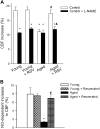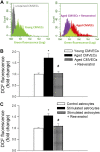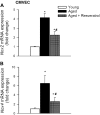Resveratrol treatment rescues neurovascular coupling in aged mice: role of improved cerebromicrovascular endothelial function and downregulation of NADPH oxidase
- PMID: 24322615
- PMCID: PMC3920140
- DOI: 10.1152/ajpheart.00744.2013
Resveratrol treatment rescues neurovascular coupling in aged mice: role of improved cerebromicrovascular endothelial function and downregulation of NADPH oxidase
Abstract
Moment-to-moment adjustment of cerebral blood flow (CBF) to neuronal activity via neurovascular coupling is essential for the maintenance of normal neuronal function. Increased oxidative stress that occurs with aging was shown to impair neurovascular coupling, which likely contributes to a significant age-related decline in higher cortical function, increasing the risk for vascular cognitive impairment. Resveratrol is a polyphenolic compound that exerts significant antiaging protective effects in large vessels, but its effects on the cerebromicrovasculature remain poorly defined. The present study was undertaken to investigate the capacity of resveratrol to improve neurovascular coupling in aging. In aged (24-mo-old) C57BL/6 mice N(ω)-nitro-l-arginine methyl ester-sensitive, nitric oxide-mediated CBF responses to whisker stimulation and to the endothelium-dependent dilator acethylcholine (ACh) were impaired compared with those in young (3-mo-old) mice. Treatment of aged mice with resveratrol rescued neurovascular coupling and ACh-induced responses, which was associated with downregulation of cortical expression of NADPH oxidase and decreased levels of biomarkers of oxidative/nitrative stress (3-nitrotyrosine, 8-isoprostanes). Resveratrol also attenuated age-related increases in reactive oxygen species (ROS) production in cultured cerebromicrovascular endothelial cells (DCF fluorescence, flow cytometry). In conclusion, treatment with resveratrol rescues cortical neurovascular coupling responses to increased neuronal activity in aged mice, likely by restoring cerebromicrovascular endothelial function via downregulation of NADPH oxidase-derived ROS production. Beneficial cerebromicrovascular effects of resveratrol may contribute to its protective effects on cognitive function in aging.
Keywords: ROS; microvascular dysfunction; oxidative stress; reactive hyperemia; senescence; vascular cognitive impairment.
Figures







References
-
- Bailey-Downs LC, Mitschelen M, Sosnowska D, Toth P, Pinto JT, Ballabh P, Valcarcel-Ares MN, Farley J, Koller A, Henthorn JC, Bass C, Sonntag WE, Ungvari Z, Csiszar A. Liver-specific knockdown of IGF-1 decreases vascular oxidative stress resistance by impairing the Nrf2-dependent antioxidant response: a novel model of vascular aging. J Gerontol Biol Med Sci 67: 313–329, 2012 - PMC - PubMed
Publication types
MeSH terms
Substances
Grants and funding
LinkOut - more resources
Full Text Sources
Other Literature Sources
Medical

